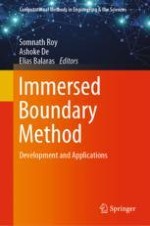2020 | OriginalPaper | Buchkapitel
4. Coupling the Curvilinear Immersed Boundary Method with Rotation-Free Finite Elements for Simulating Fluid–Structure Interaction: Concepts and Applications
verfasst von : Anvar Gilmanov, Henryk Stolarski, Fotis Sotiropoulos
Erschienen in: Immersed Boundary Method
Verlag: Springer Singapore
Aktivieren Sie unsere intelligente Suche, um passende Fachinhalte oder Patente zu finden.
Wählen Sie Textabschnitte aus um mit Künstlicher Intelligenz passenden Patente zu finden. powered by
Markieren Sie Textabschnitte, um KI-gestützt weitere passende Inhalte zu finden. powered by
